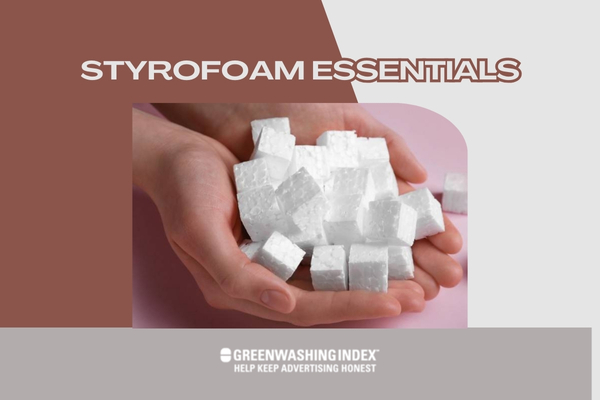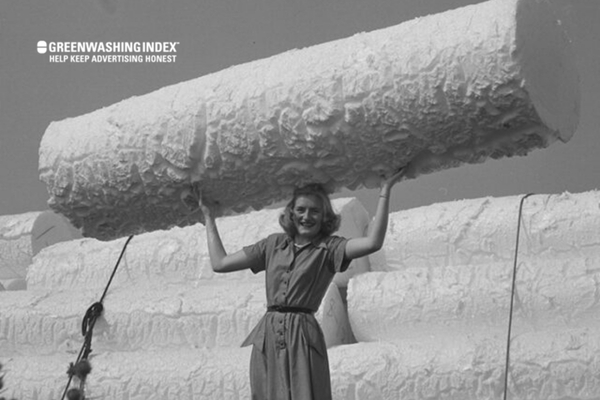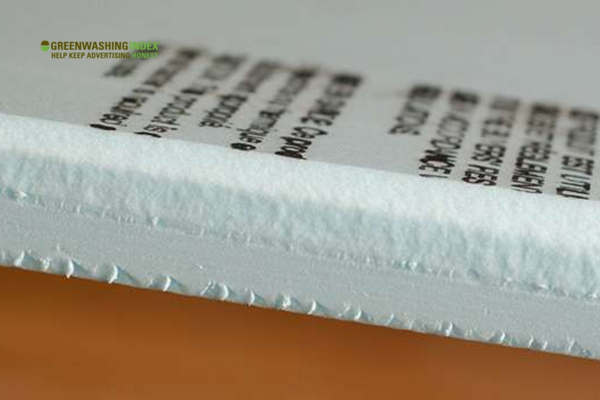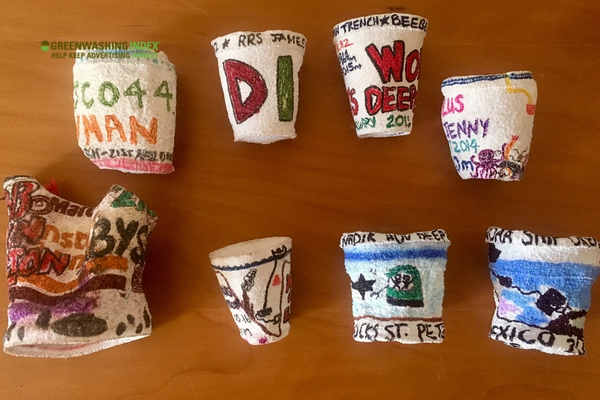

Have you ever sipped a hot drink from a light, foam cup and wondered what it’s made of? This weightless wonder, commonly called Styrofoam, is all around us! From your coffee cup to the insulation in homes, it plays a huge part in our daily lives.
Let’s take an exciting dive into the world of this remarkable material. You might think it’s just for keeping things hot or cold – but there’s so much more to discover about Styrofoam!
Styrofoam, as many call it, is actually a brand name that has become synonymous with a variety of foam products. But if we dive deep into what Styrofoam truly stands for, we’ll find ourselves amid fascinating facts and myths just waiting to be uncovered!
Typically seen in packaging or construction materials, this foam has properties that make it essential for modern living—lightweight yet strong, great at insulating yet affordable. So let me clear up any confusion and share the real story behind this ubiquitous material.
What You’ll Discover Here:

Sometimes, the words we use every day don’t mean what we think they do. Take Styrofoam, for instance. What comes to mind when you hear that? Maybe you think of those white foam cups you drink hot coffee from or the material that protects your new TV in its box.
When I talk about Styrofoam, I’m talking about something you’ve probably seen a lot. It’s that white, light material used in coffee cups and to keep electronics safe in boxes when you buy them. But what exactly is it made of, and what does it look like up close?
Styrofoam is actually a brand name. The real thing it refers to is a type of foam called Extruded Polystyrene Foam or XPS for short. It’s mostly air! Imagine blowing bubbles into a thick, gooey syrup until it gets all puffed up – that’s similar to how Styrofoam is made.
Now let me get into the details:
First off, Styrofoam starts with polystyrene, which is a kind of plastic. Plastic, as you might know, comes from oil – the same stuff we use for fuel in our cars. So we take this polystyrene plastic and then comes the cool part – we add some chemicals to it and heat this mix up until it melts.
After melting, we force this hot, now liquid plastic through a specially shaped hole or die (think about squeezing playdough through different caps). As this happens, another chemical called blowing agent is mixed in which causes the liquid mix to expand immensely – just like dough rises thanks to yeast!
The final result of these processes? A solid foam that has little pockets of air trapped inside making it super lightweight!
Believe me when I say its physical characteristics are pretty neat:
Understanding what Styrofoam consists of helps us see why it’s everywhere around us. From packing materials hogging space under our Christmas tree gifts to lining house walls for insulation – this fluffy yet strong material has got lots covered!
To sum up: Styrofoam, or really XPS foam when we’re being exact about terminology, may seem simple but there’s so much more than meets the eye —it’s pumped-up plastic with countless uses thanks to its fascinating makeup and properties.

Sometimes, the everyday things that we take for granted have the most interesting stories behind them. Take Styrofoam, for instance. Its journey from a lab discovery to a material we use all the time is fascinating.
Styrofoam. It’s a word we all know. But where did this material come from? Why was it even made? Let’s take a dive into the past and find out how Styrofoam came to be.
Back in the 1940s, there was a company named Dow Chemical. They had smart people, called scientists, working on new stuff. These smart folks came up with a kind of foam that was quite special – it could keep things warm or cool, and it was super light.
The real name for what many call Styrofoam is actually ‘extruded polystyrene foam’. I think that’s quite a mouthful, right? That’s why we often just say Styrofoam. It rolls off the tongue much easier.
Ray McIntire was one of those smart people at Dow Chemical. One day, he made an interesting mistake while trying to make something else − he ended up creating this foam by accident! He mixed together styrene with other chemicals under heat and pressure − and poof! − there it was.
What Ray made didn’t look like what we see today as cups or containers at first.
It started off as a hard plastic sort of thing called polystyrene. But when you shoot air into hot polystyrene, magic happens! It’s not real magic, just science − but it feels like magic when you see the hard plastic puff up into a firm foam.
Now why did this become big news? Because during World War II people needed good insulation for stuff like airplanes and vehicles in cold places. They also needed materials that wouldn’t weigh much because heavy planes are not good for flying high!
Styrofoam fit that needs just perfect with its properties − keeping heat out or in, being tough yet lightweight.
Over time (remember we’ve been talking about lots of years passing), folks found more uses for this neat material: packing peanuts to keep products safe when shipped across the world or building insulation to keep homes warm without wasting energy on heating up the outside air too!
That’s how styrofoam made its big entrance into our lives – through an accident that turned into such useful stuff for so many things around us every day!

It’s easy to get mixed up with all the different types of foamy materials out there. A lot of folks call anything that’s light and foamy “Styrofoam,” but that’s not quite right. I’m going to explain exactly how Expanded Polystyrene (EPS), Extruded Polystyrene (XPS), and the brand name Styrofoam are different from one another.
Lots of times, when people talk about “Styrofoam,” they get things mixed up. They might be talking about different kinds of stuff that seem alike but are really not the same thing! I’m here to set the story straight. We’ll look closely at three materials: Expanded Polystyrene (EPS), Extruded Polystyrene (XPS), and what most people call “Styrofoam.”
So now you know: even if they’re all foamy and mostly white, EPS isn’t XPS, and what many folks call “Styrofoam” is usually just EPS or another kind of foam entirely—unless we’re talking about those blue boards made by Dow Chemical Company.
By sorting out these differences clearly:
EPS – Think of packing peanuts.
XPS – Consider hard insulating boards.
“Styrofoam” – Often misused; actually a specific brand making mostly blue insulation.
Next time someone tosses around the word ‘Styrofoam’, you can help clear up the mix-up!

Styrofoam is a material that most folks know. It pops up in many areas of our daily lives, but what some may not realize is that there are different kinds of Styrofoam crafted for specific uses. Let’s delve a bit deeper into these types, shall we?
When I talk about Extruded Polystyrene Foam, which you might know as XPS, you need to understand its very special makeup. XPS is made through a process that melts together plastic resin and other materials. As it does this, the mixture is forced out through a shape. Air bubbles are mixed in, which makes XPS light but very strong.
Let’s look closely at why people pick XPS for certain jobs. First off, because it’s tough and water-resistant, it’s perfect for insulation used in walls, roofs, and floors in houses or buildings. This means that the building stays warm when it’s cold out and cool when it’s hot without wasting much energy.
Next up are its uses beyond keeping places comfy temperature-wise. Sometimes, you see it on the road as those orange traffic cones or even model planes that hobbyists love to put together.
In short: Why do people love XPS? It’s strong, keeps water out well, and insulates like a champ!
Now I’m turning my attention to Expanded Polystyrene Foam, known widely as EPS. This one starts off similarly—think small beads of polystyrene. But here’s where things get interesting; these beads puff up with steam until they’re many times their original size! Imagine popcorn popping—that’s kind of what happens here.
Once these little beads have puffed up big time, they fuse together into whatever shape is needed—like packaging material or coffee cups that keep our hands from getting too hot.
But EPS isn’t just about stopping your hand from burning; it’s helpful in bigger ways too! In building projects all over the place—you’ll find these foamy EPS materials keeping houses warm or cool by being part of the walls themselves!
So why do we care about EPS? It can be molded into lots of shapes easily and is super lightweight yet durable enough for shipping delicate things all over the world.
Next up on our Styrofoam journey is something called High-Impact Polystyrene, also known as HIPS. Just by hearing its name—”high-impact”—you get the idea that this styrofoam type punches above its weight when dealing with rough handling.
What makes HIPS stand out? Well, think toughness—a lot like regular polystyrene but add rubber! The added rubber makes HIPS able to handle bumps and drops without breaking down so easily.
Think about your TV remote controller—that plastic needs to not crack every time it accidentally slips from your hand onto the floor—HIPS works flawlessly here due to its hardiness!
In brief: What sets HIPS apart? It takes a beating without getting beat!
Last but not least are what we call Styrofoam Insulation Boards—these boards are key warriors in fighting against wasted energy in buildings because they trap air inside them really well—which means heat doesn’t escape easily during winter and stays outside during summer.
Why use Styrofoam insulation boards then? They’re effective at cutting down on energy bills by minimizing how much heat goes wandering off where we don’t want it!
And there you have them – different types of Styrofoam each with their own roles from saving energy with insulation efforts to toughening up gadget casings! Each type has been carefully designed to match our varied needs like a snug-fitting glove!
We all use the word “Styrofoam” a lot. We use it to talk about those white cups we drink our coffee from or the containers we get our food in. But I’ve got news for you, and it might be a bit of a shock: those foam cups aren’t Styrofoam at all!
1. Common Misconception:
2. What Is ‘Styrofoam’ Really?
3. What Are Most Disposable Foam Cups Made Of?
4. Characteristics of Expanded Polystyrene (EPS):
5. Why The Mix-Up?
Remember, while it may seem trivial to differentiate between Styrofoam and EPS, calling them by their proper names can contribute towards environment-conscious practices regarding the use and disposal of these materials.
No, microwaving food in Styrofoam containers is not safe. High heat can cause chemicals to leach into the food.
Yes, there are biodegradable options like plant-based foam and paper-based materials that are eco-friendlier than traditional Styrofoam.
Definitely! Styrofoam can be creatively reused for insulation, gardening, and various craft projects, giving it a second life.
After taking an in-depth look at Styrofoam, it’s clear that this material is more than just a simple foam cup or peanut for packing. We’ve learned the exact composition of Styrofoam and the various types, such as XPS, EPS, and HIPS.
Now we’re aware of their specific uses and characteristics. We also dug into the history of how Styrofoam was invented and how it’s become a staple in our daily lives.
Key Takeaway Points:
